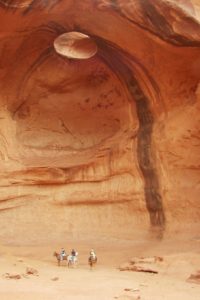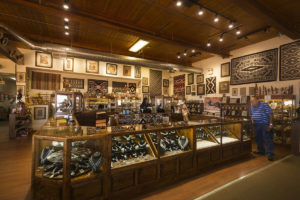About Monument Valley
Monument Valley consists of over 91,000 acres. The entrance is located in Utah, but the Valley extends into Arizona. Many of the most-photographed rock formations are in Utah. Today, Monument Valley is a Navajo Nation Tribal Park.
In the Navajo language, Monument Valley is called Tse′ Bii’ Ndzisgaii, which means white streaks amid the rocks, or clearing among the rocks. The Navajo regarded this area as an enormous hogan (traditional Navajo dwelling) with Gray Whiskers and Sentinel pinnacles as its door posts. The fireplace is the butte near Goulding’s Lodge. Its door faces east near the Tribal Park ranger station. Two soaring buttes, known as the Mittens, were thought to be the hands of a deity.
History
Archeologists have identified more than 100 ancient Ancestral Puebloan (also known as Anasazi) sites and ruins dating prior to 1300 A.D. The valley was abandoned by the Ancestral Puebloans in the 1300’s, as were other areas in the Four Corners region.
The date of the first Navajo settlement in Monument Valley is unknown. For hundreds of years, the Navajo have raised sheep and other livestock, and farmed small quantities of crops in the valley.
When the Navajo were forced out of Canyon De Chelly by the U.S. Army during the “Long Walk”, some took refuge in Monument Valley. An 1868 treaty allowed their return to their ancestral homeland and established the Navajo Reservation. Other parts of Monument Valley were added to the Navajo Reservation in 1884 and 1933. An estimated 100 Navajo people live in the valley today.
In 1958, the Navajo Tribal Council established the tribal park making the area accessible to tourists. The park was designated in 1960. Viewed as a uniquely American icon, over 400,000 people from all over the world visit Monument Valley annually, providing a major source of income to the Navajo people.
Geology
Near the center of the Colorado Plateau at almost 5,600 feet in elevation, the area was once a lowland basin. Over hundreds of millions of years, sediment layers eroded from the Rocky Mountains were deposited. A slow, gentle uplift elevated the sediment layers to a height of 1 – 3 miles above sea level, making the area into a plateau. Wind and water erosion over the last 50 million years cut into the surface of the plateau, carving the layers of soft and hard rock into the magnificent mesas, buttes, pinnacles and monolith rock formations of today.
The Movies–Where God Put the West
In the mid-1920’s, Harry Goulding and his wife Mike, established a nearby trading post still in operation today. After the Depression and two major droughts, trading post income was markedly diminished as very few visitors came to the area. Learning that a major Hollywood studio was looking to film a Western on location, Harry, along with a photographer, began to photograph the valley and developed a breathtaking photo album. In 1938, the Gouldings traveled to the studio in Los Angeles. Without an appointment, Goulding arrived and stated he would wait until he could be seen. Soon, director John Ford saw Goulding’s photo album, and it wasn’t long thereafter that Ford began filming the 1939 movie, Stagecoach, with John Wayne in Monument Valley. Ford went on to make seven more films in Monument Valley over 25 years including My Darling Clementine, She Wore a Yellow Ribbon, and The Searchers. The cabin used in scenes from She Wore A Yellow Ribbon still stands and can be toured at nearby Goulding’s Lodge.
Film critic, Keith Phipps, stated that Monument Valley’s “five square miles have defined what decades of moviegoers think of when they imagine the American West.” Other movies such as Easy Rider, Thelma and Louise, Back to the Future III, The Eiger Sanction, 2001: A Space Odyssey, National Lampoon’s Vacation, and The Lone Ranger have filmed in Monument Valley. More recently, HBO’s Westworld television series filmed in the Valley.
Forrest Gump Hill
About 33 miles from Bluff, as you approach the park, you will most likely recognize a famous image of Monument Valley, and one of the most famous images in the Southwest – a long, straight, empty road running across the flat desert towards the stark red cliffs on the horizon. Remember the shot where Forrest Gump stopped running and turned to go back to Alabama? You can find Forrest Gump Hill around mile marker 13 on Highway 163.
Please remember that vehicles travel very fast on Highway 163. If you stop for a photo, take precautions to get off the road and away from cars as they pass.
Touring the Park
Monument Valley is all about learning more about the Navajo culture and the views of magnificent buttes, spires, mesas, and pinnacles.
You can drive the 17-mile, unpaved park loop in your car. Note the road can be quite bumpy in some areas. After a rain, the road may be quite difficult.
Along the 17-mile loop are 11 scenic stops with descriptive names. The iconic Mittens are visible from the Visitors Center. When viewed from the south, the East and West Mittens appear like two gigantic mittens with thumbs facing inward. You will be able to appreciate why the Navajo think these are the hands of a deity. Nearby is Merrick Butte, which forms a triangle with the East and West Mittens, and is named for a silver hunter who met his demise here in the 1860’s.

The Navajo ask that you do not climb on the monuments while visiting the park.
Jeep tours, available from companies located nearby the Visitors Center, as well at Gouldings Lodge, are also an excellent way to see the park, and learn more about Navajo traditions and history.
Another great way to see the park is on horseback. Guided horseback rides, available through Navajo companies located just outside the Visitors Center, will provide you with a truly memorable experience. You will be able to access areas of the park not on the Park Loop such as the Eye of God Arch.
Some guides can also take you to Hunt’s Mesa which is a much longer tour. Two hours travel time are needed to get to the mesa peak. The overnight camping trip is 18 hours. Camping on Hunt’s Mesa was rated by Cowboys and Indians magazine as the 2011’s Best of the West pick.
Booking Tours in Monument Valley
In the parking lot of the Visitors Center, you can arrange for Jeep tours, or horseback tours at various kiosks on the day you visit the park. You can also prebook a tour from one of the guides on the Monument Valley Tour Operators website.
Monument Valley Visitor Center

The Visitors Center has a lovely gift shop featuring beautiful Navajo textiles and jewelry, along with Monument Valley memorabilia. The View Restaurant and a deli are also located in the Visitors Center.
You will want to spend time on one of several verandas at the Visitors Center where you can take in the views of The Mittens and the park.
Restrooms and ample parking are available at the Visitors Center.
Hours of Operation
- April 1 – September 30 (Peak Season): 6 a.m. – 8 p.m., 7 days a week
- October 1 – March 30 (Off Season): 8 a.m. – 5 p.m., 7 days a week
- CLOSED: Thanksgiving Day, Christmas Day, and New Year’s Day
Park Hours
The park’s 17-mile Scenic Valley Drive is open from May – September from 6:00 – 8:30 p.m. In the winter season, from October – April, the drive is open from 8:00 a.m. – 4:30 p.m.
Time Zones
Bluff, Utah is on Mountain Standard Time, which is the same time zone as Denver, Colorado. Monument Valley is located in both Utah and Arizona. Monument Valley Tribal Park does observe Daylight Savings Time. Arizona, however, does not observe Daylight Savings Time and may be 1 hour behind Bluff. This is especially important in summer months for visitors who wish to watch the sun go down in Monument Valley, and then travel to Bluff for dinner and lodging. Check the time zones carefully.
Park Fees
A kiosk is located at the park entrance. You will need to pay the entrance fee to go to the Visitors Center or to travel the park loop.
Per Vehicle Pass: $20 per non-commercial vehicle up to 4 people ($6 each additional passenger)
Per Individual Pass: $10 per walk-in, bicycle, or motorcycle
Commercial Pass: (based on capacity of vehicle)
- 1-4 Passengers: $35 (additional $6 each)
- 5-15 Passengers: $100
- 15-25 Passengers: $125
- 26+ Passengers: $300
General Admission passes do not include Backcountry Permits.
Nearby Attractions
Monument Valley is a key stop on the Grand Circle, which includes the Grand Canyon, Bryce, Zion, Capitol Reef, Canyonlands, and Arches National Parks. Valley of the Gods and Goosenecks State Park are great stops on the way from Bluff to Monument Valley on Highway 163.
Getting There
Directions from Bluff: Monument Valley is 50 miles southwest of Bluff on US 163, the only main road leading to Monument Valley. Travel time is about 1 hour. Signs to the Monument Valley Tribal Park are well marked. Take a left traveling to the park, and pay at the Visitors Center to enter the park.
Sources:
1. Phipps, K. 2009, November. The Easy Rider Road Trip. Slate.com. Retrieved January 25, 2013. 2. Best of the West 2011. Cowboys and Indians. June 2011. 3. Navajo Nation Parks and Recreation. Monument Valley Navajo Tribal Park. Navajonationparks.org. Retrieved January 25, 2013. 4. Perrottet T. Behind the Scenes in Monument Valley. Smithsonian. February 2010. 5. Leach N. 2005. Kit Carson and The Long Walk. In Cindy Bohn, Monument Valley Navajo Tribal Park and the Navajo Reservation (p.22). Mariposa, CA: Sierra Press. 6. McPherson R. Thru Navajo Eyes, Bluff to Monument Valley. 2014 Four Corners Digital Design.



